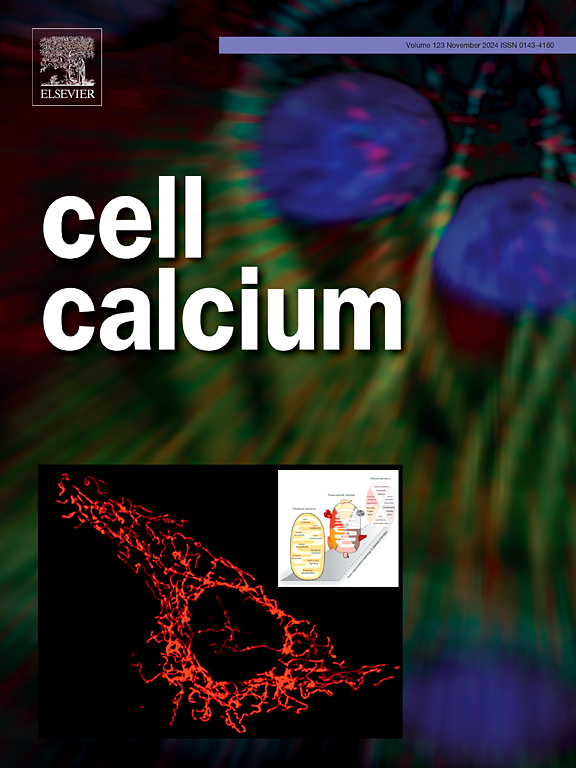Rapid quantification of intracellular calcium stores reveals effects of membrane micropeptides on SERCA function
IF 4.3
2区 生物学
Q2 CELL BIOLOGY
引用次数: 0
Abstract
To determine how regulation of the sarco(endo)plasmic reticulum calcium ATPase (SERCA) affects the Ca2+ content of the endoplasmic reticulum (ER), we developed a ratiometric ER-localized Ca2+ indicator to rapidly quantify Ca2+ stores and assess SERCA function in live cells. This assay enables screening of membrane micropeptides and small molecules that modulate SERCA and Na+/K+-ATPase activity and may facilitate development of therapies that target cellular Ca2+ handling. Of the micropeptides tested, phospholamban (PLB) had the greatest degree of inhibition of SERCA, as measured by a decrease in ER Ca2+ content compared to control. Sarcolipin (SLN), endoregulin (ELN), and another-regulin (ALN) also decreased ER Ca2+ content, though less potently than PLB. We also investigated micropeptides that have been shown to have a positive effect on ER Ca2+ uptake. Dwarf open reading frame (DWORF), a positive modulator of SERCA activity, and phospholemman (PLM), an inhibitor of the Na+/K+-ATPase, both increased ER Ca2+ content compared to control. A superinhibitory variant of PLM, R70C, further increased ER Ca2+ load compared to wild type PLM. Overall, our findings indicate that the inhibitory potency of micropeptides is governed by their relative binding affinities to SERCA. This allows for finely tuned modulation of Ca2+ handling in different tissues based on differential expressions of micropeptide species. Understanding the contribution of each micropeptide to SERCA regulation may reveal novel strategies for therapeutic intervention in conditions where calcium dysregulation plays a role, such as heart disease, vascular disease, or neurodegenerative disorders.

细胞内钙储存的快速定量揭示了膜微肽对SERCA功能的影响
为了确定sarco(内do)质网钙atp酶(SERCA)的调节如何影响内质网(ER)的Ca2+含量,我们开发了一种比例内质网定位的Ca2+指标,以快速量化Ca2+储存并评估活细胞中的SERCA功能。该分析能够筛选调节SERCA和Na+/K+- atp酶活性的膜微肽和小分子,并可能促进针对细胞Ca2+处理的治疗的发展。在所测试的微肽中,磷蛋白(PLB)对SERCA的抑制程度最大,与对照相比,其ER Ca2+含量降低。肌磷脂(SLN)、内调节蛋白(ELN)和另一调节蛋白(ALN)也能降低内质网Ca2+含量,但效果不如PLB。我们还研究了已被证明对ER Ca2+摄取有积极影响的微肽。与对照组相比,SERCA活性的正调节因子Dwarf open reading frame (DWORF)和Na+/K+- atp酶抑制剂phospholemman (PLM)均增加了ER Ca2+含量。与野生型PLM相比,PLM的超抑制变体R70C进一步增加了ER Ca2+负荷。总的来说,我们的研究结果表明,微肽的抑制效力是由它们与SERCA的相对结合亲和力决定的。这允许精细调节Ca2+处理在不同组织中基于微肽物种的差异表达。了解每种微肽对SERCA调节的作用,可能会为钙失调起作用的疾病(如心脏病、血管疾病或神经退行性疾病)的治疗干预提供新的策略。
本文章由计算机程序翻译,如有差异,请以英文原文为准。
求助全文
约1分钟内获得全文
求助全文
来源期刊

Cell calcium
生物-细胞生物学
CiteScore
8.70
自引率
5.00%
发文量
115
审稿时长
35 days
期刊介绍:
Cell Calcium covers the field of calcium metabolism and signalling in living systems, from aspects including inorganic chemistry, physiology, molecular biology and pathology. Topic themes include:
Roles of calcium in regulating cellular events such as apoptosis, necrosis and organelle remodelling
Influence of calcium regulation in affecting health and disease outcomes
 求助内容:
求助内容: 应助结果提醒方式:
应助结果提醒方式:


